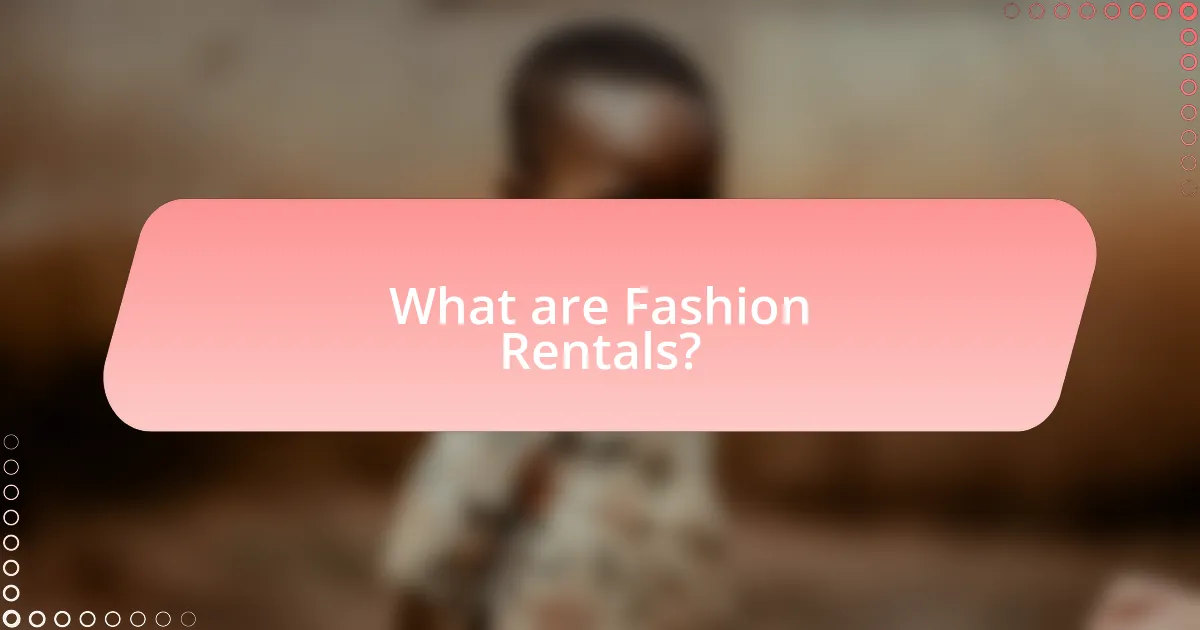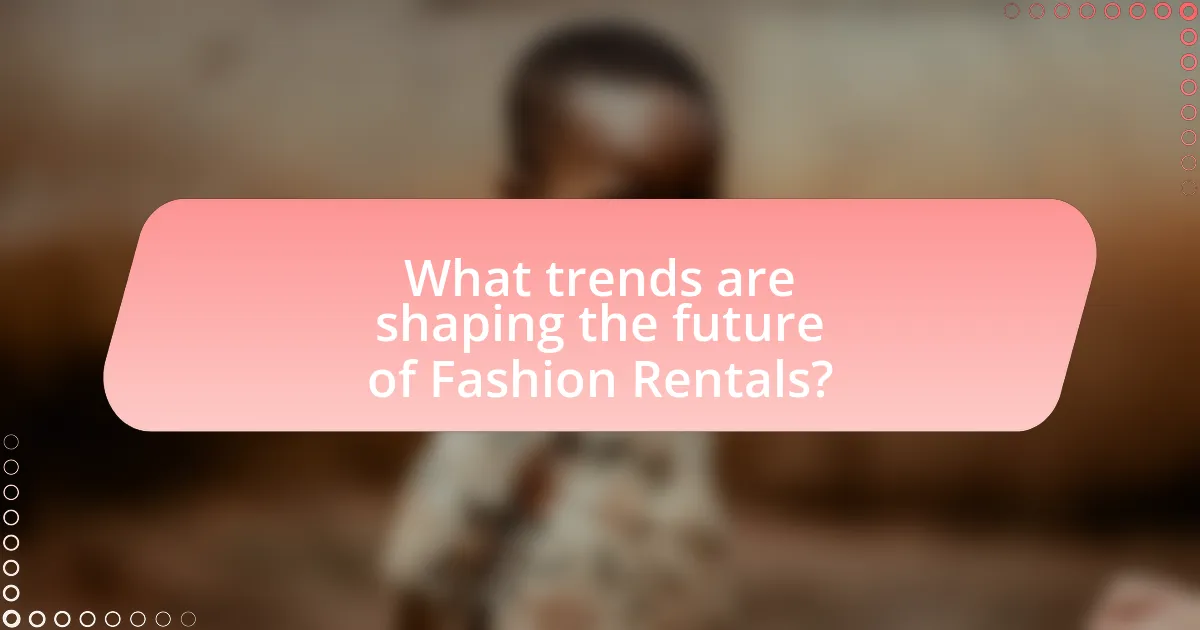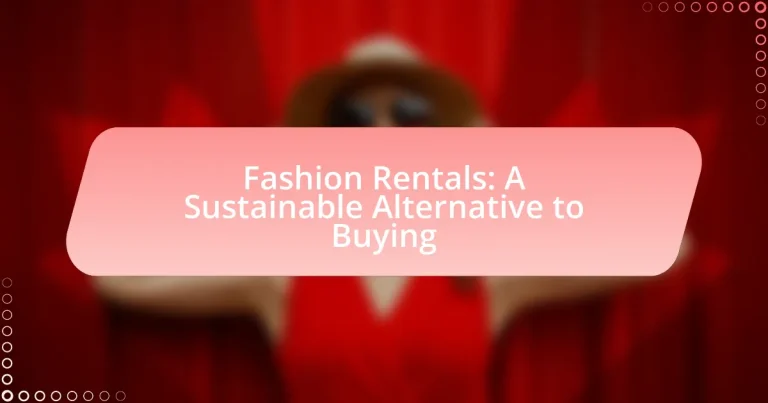Fashion rentals are services that enable individuals to rent clothing and accessories for a limited time, promoting sustainability by reducing waste and encouraging garment reuse. This article explores the operational model of fashion rentals, the types of items available, and the economic and environmental benefits they offer as a sustainable alternative to fast fashion. It also addresses challenges faced by rental companies, consumer perceptions regarding quality and hygiene, and the impact of technology on the industry. Additionally, the article highlights emerging markets and cultural shifts driving the popularity of fashion rentals, providing practical tips for consumers to enhance their rental experience.

What are Fashion Rentals?
Fashion rentals are services that allow individuals to rent clothing and accessories for a specified period instead of purchasing them outright. This model promotes sustainability by reducing waste and encouraging the reuse of garments, which aligns with the growing trend of eco-conscious consumerism. According to a report by McKinsey & Company, the fashion rental market is projected to grow significantly, reflecting a shift in consumer behavior towards more sustainable practices in the fashion industry.
How do Fashion Rentals operate in the market?
Fashion rentals operate in the market by providing consumers access to high-quality clothing and accessories for a limited time, typically through an online platform. These businesses acquire inventory from designers and brands, which they then offer to customers for rental at a fraction of the retail price. This model allows consumers to enjoy luxury fashion without the commitment of purchase, promoting sustainability by reducing waste and encouraging the reuse of garments. According to a report by McKinsey & Company, the global online rental market is projected to grow significantly, indicating a rising consumer preference for rental services as a sustainable alternative to fast fashion.
What types of clothing and accessories are typically available for rent?
Clothing and accessories typically available for rent include formal wear, casual attire, designer dresses, suits, handbags, shoes, and jewelry. Rental services often focus on high-demand items for special occasions, such as weddings and parties, providing access to luxury brands at a fraction of the retail price. This model supports sustainability by reducing waste and promoting the reuse of garments, aligning with the growing trend of eco-conscious consumerism in the fashion industry.
How do rental processes differ from traditional purchasing?
Rental processes differ from traditional purchasing primarily in ownership and duration of use. In rental processes, consumers pay for temporary access to items without acquiring ownership, while traditional purchasing involves a one-time payment for full ownership of the item. For example, in fashion rentals, customers select garments for a specific period, often for events, and return them afterward, whereas purchasing requires a commitment to keep the item indefinitely. This model promotes sustainability by reducing waste and encouraging the reuse of clothing, as evidenced by the growing popularity of rental services, which have increased by 63% in the last five years, according to a report by Allied Market Research.
Why are Fashion Rentals considered a sustainable alternative?
Fashion rentals are considered a sustainable alternative because they reduce waste and resource consumption associated with fast fashion. By allowing consumers to rent clothing instead of purchasing new items, fashion rentals extend the lifecycle of garments, minimizing the environmental impact of production and disposal. According to a report by the Ellen MacArthur Foundation, the fashion industry is responsible for 92 million tons of waste annually, and renting can significantly decrease this figure by promoting reuse. Additionally, renting reduces the demand for new clothing production, which often involves harmful practices such as excessive water usage and chemical pollution.
What environmental impacts does fast fashion have?
Fast fashion significantly contributes to environmental degradation through excessive resource consumption, pollution, and waste generation. The industry is responsible for approximately 10% of global carbon emissions, primarily due to the energy-intensive processes involved in manufacturing and transporting garments. Additionally, fast fashion leads to water pollution, as the dyeing and finishing processes release toxic chemicals into waterways, affecting aquatic ecosystems. The production of synthetic fibers, such as polyester, further exacerbates the issue by contributing to microplastic pollution in oceans. Furthermore, fast fashion promotes a culture of disposability, resulting in an estimated 92 million tons of textile waste generated annually, much of which ends up in landfills. These facts illustrate the profound environmental impacts of fast fashion, highlighting the urgent need for sustainable alternatives like fashion rentals.
How do Fashion Rentals reduce waste and promote sustainability?
Fashion rentals reduce waste and promote sustainability by extending the lifecycle of clothing and minimizing the demand for new production. By allowing consumers to rent garments instead of purchasing them, fashion rental services decrease the volume of textile waste generated, as items are reused multiple times. According to a report by the Ellen MacArthur Foundation, the fashion industry is responsible for 92 million tons of waste annually, and rental models can significantly mitigate this impact by promoting a circular economy. Additionally, renting reduces the carbon footprint associated with manufacturing new clothing, as it lessens the need for raw materials and energy-intensive production processes.
What are the economic benefits of Fashion Rentals?
Fashion rentals provide significant economic benefits by reducing consumer spending on clothing and promoting a circular economy. By renting instead of purchasing, consumers can access high-quality garments at a fraction of the retail price, which can lead to savings of up to 90% on designer items. This model also encourages sustainable consumption, as it minimizes waste and extends the lifecycle of clothing, ultimately reducing the costs associated with production and disposal. Additionally, the fashion rental industry has seen rapid growth, with the global market projected to reach $1.96 billion by 2025, indicating a shift in consumer behavior towards more economical and environmentally friendly options.
How do Fashion Rentals save consumers money?
Fashion rentals save consumers money by allowing them to access high-quality clothing and accessories for a fraction of the retail price. Instead of purchasing expensive items that may only be worn once or twice, consumers can rent these items for special occasions or seasonal use, significantly reducing their overall spending. For example, renting a designer dress can cost as little as 10% of its retail price, enabling consumers to enjoy luxury fashion without the financial burden of ownership. Additionally, fashion rentals often include maintenance and cleaning services, further decreasing the costs associated with garment care.
What is the impact of Fashion Rentals on the fashion industry?
Fashion rentals significantly impact the fashion industry by promoting sustainability and reducing waste. This model allows consumers to access high-quality garments without the need for ownership, thereby decreasing the demand for fast fashion production, which is responsible for substantial environmental degradation. According to a report by McKinsey & Company, the fashion industry accounts for 10% of global carbon emissions, and fashion rentals can help mitigate this by extending the lifecycle of clothing. Additionally, the rise of fashion rental services has led to a shift in consumer behavior, with more individuals prioritizing experiences over ownership, which further influences brands to adopt more sustainable practices.

What challenges do Fashion Rentals face?
Fashion rentals face several challenges, including inventory management, customer trust, and logistics. Inventory management is critical as rental companies must maintain a diverse selection of high-quality garments while minimizing costs associated with storage and maintenance. Customer trust is essential, as potential renters may be hesitant to rent clothing due to concerns about cleanliness, fit, and the condition of items. Logistics presents another challenge, as timely delivery and return processes are crucial for customer satisfaction; inefficiencies can lead to negative experiences and lost business. According to a report by McKinsey & Company, the fashion rental market is projected to grow significantly, but addressing these challenges is vital for sustainable growth and customer retention.
What are the common misconceptions about Fashion Rentals?
Common misconceptions about fashion rentals include the belief that rented clothing is always of lower quality, that it is only suitable for special occasions, and that it is not cost-effective. Many people assume that rental garments are inferior, but reputable rental services often provide high-quality, designer items that are well-maintained. Additionally, the notion that rentals are limited to events like weddings or parties overlooks the growing trend of everyday fashion rentals, which cater to regular wear. Lastly, while some may think renting is more expensive than purchasing, studies show that renting can be more economical, especially for those who frequently update their wardrobes or seek variety without the commitment of buying.
How do consumers perceive the quality of rented items?
Consumers perceive the quality of rented items as variable, often influenced by brand reputation, item condition, and rental service quality. Research indicates that consumers tend to associate higher quality with well-known brands, as they often have established standards for their products. Additionally, the physical condition of the rented item plays a crucial role; items that show signs of wear or damage can lead to negative perceptions of quality. A study published in the Journal of Fashion Marketing and Management found that 70% of consumers reported that the perceived quality of rented clothing significantly affects their willingness to rent again. This highlights the importance of maintaining high standards in the rental process to ensure positive consumer perceptions.
What concerns do people have regarding hygiene and maintenance?
People have significant concerns regarding hygiene and maintenance in fashion rentals, primarily due to the potential for contamination and the cleanliness of garments. Many individuals worry that rented clothing may not be adequately cleaned between uses, leading to the transmission of bacteria, allergens, or odors. A survey conducted by the Fashion Rental Association found that 70% of respondents expressed apprehension about the hygiene standards of rental services. Additionally, maintenance issues such as the quality of fabric care and the durability of rented items are also prevalent concerns, as consumers fear that improper handling could lead to damage or a decline in the garment’s appearance.
How do Fashion Rentals address logistical challenges?
Fashion rentals address logistical challenges by implementing efficient inventory management systems and streamlined shipping processes. These systems allow rental companies to track garment availability in real-time, reducing the risk of overbooking and ensuring that customers receive their selected items on time. For instance, many fashion rental services utilize advanced software that integrates with their supply chain, enabling quick turnaround times for cleaning, repairs, and restocking. This operational efficiency is supported by data indicating that companies employing such technologies can reduce delivery times by up to 30%, thereby enhancing customer satisfaction and operational reliability.
What are the key factors in managing inventory for rental services?
The key factors in managing inventory for rental services include accurate demand forecasting, efficient inventory tracking, and effective maintenance protocols. Accurate demand forecasting allows rental services to predict customer needs and adjust inventory levels accordingly, reducing excess stock and minimizing costs. Efficient inventory tracking systems, such as RFID technology, enable real-time monitoring of items, ensuring availability and reducing losses. Effective maintenance protocols are crucial for preserving the quality of rental items, as regular inspections and cleaning can extend the lifespan of products and enhance customer satisfaction. These factors collectively contribute to streamlined operations and improved profitability in the rental service sector.
How do rental companies handle shipping and returns?
Rental companies typically manage shipping and returns by providing customers with pre-paid shipping labels for easy return of items. This process often includes clear instructions on how to package and send back the rented items, ensuring that customers can return them without incurring additional costs. Many rental companies also utilize tracking systems to monitor the return process, which helps maintain inventory accuracy and customer satisfaction. For instance, companies like Rent the Runway and Le Tote have established streamlined logistics to facilitate efficient shipping and returns, contributing to their operational success in the fashion rental market.

What trends are shaping the future of Fashion Rentals?
The future of fashion rentals is being shaped by several key trends, including sustainability, technological advancements, and changing consumer behaviors. Sustainability is driving demand as consumers increasingly seek eco-friendly options, with the global fashion rental market projected to reach $1.96 billion by 2025, reflecting a shift towards more responsible consumption. Technological advancements, such as mobile apps and AI-driven recommendations, enhance user experience and streamline the rental process, making it more accessible. Additionally, changing consumer behaviors, particularly among millennials and Gen Z, emphasize the desire for variety and affordability, leading to a growing acceptance of renting as a viable alternative to ownership. These trends collectively indicate a significant transformation in how consumers engage with fashion.
How is technology influencing the Fashion Rental industry?
Technology is significantly influencing the Fashion Rental industry by enhancing user experience, streamlining operations, and promoting sustainability. Online platforms and mobile applications allow consumers to easily browse, select, and rent fashion items from the comfort of their homes, increasing accessibility and convenience. Additionally, advancements in inventory management systems enable rental companies to efficiently track and manage their stock, reducing waste and optimizing supply chains. A report by McKinsey & Company indicates that the global online rental market is projected to grow by 10% annually, reflecting the increasing consumer preference for rental services over ownership. This shift not only supports sustainable fashion practices but also aligns with the growing demand for eco-friendly alternatives in the apparel industry.
What role do mobile apps play in enhancing user experience?
Mobile apps significantly enhance user experience by providing convenience, personalization, and accessibility. They allow users to browse fashion rental options seamlessly, facilitating quick selections and transactions. According to a study by Statista, 90% of mobile users prefer apps over mobile websites for their speed and ease of use, which directly contributes to a more satisfying shopping experience. Additionally, mobile apps can leverage user data to offer tailored recommendations, further improving engagement and satisfaction.
How are data analytics used to improve rental services?
Data analytics are used to improve rental services by optimizing inventory management, enhancing customer experience, and predicting demand trends. For instance, rental companies analyze customer data to identify popular items and adjust their inventory accordingly, ensuring high-demand products are readily available. Additionally, data analytics enable personalized marketing strategies by segmenting customers based on their preferences and behaviors, leading to increased engagement and satisfaction. Furthermore, predictive analytics help rental services forecast demand fluctuations, allowing for better resource allocation and pricing strategies. This data-driven approach has been shown to increase operational efficiency and customer retention in the rental industry.
What are the emerging markets for Fashion Rentals?
The emerging markets for fashion rentals include Asia-Pacific, particularly China and India, as well as Latin America, especially Brazil and Mexico. These regions are experiencing rapid urbanization, increasing disposable incomes, and a growing awareness of sustainable fashion practices. For instance, the Asia-Pacific fashion rental market is projected to grow significantly, with a compound annual growth rate (CAGR) of over 10% from 2021 to 2028, driven by the rise of e-commerce and changing consumer behaviors. In Latin America, the demand for affordable luxury and eco-friendly options is propelling the growth of rental services, with Brazil’s fashion rental market expected to expand as consumers seek alternatives to fast fashion.
How are Fashion Rentals expanding into new demographics?
Fashion rentals are expanding into new demographics by targeting younger consumers, particularly millennials and Gen Z, who prioritize sustainability and affordability. This demographic shift is evidenced by the rise of platforms like Rent the Runway and HURR Collective, which cater to eco-conscious individuals seeking stylish, temporary wardrobe options. Additionally, fashion rental services are diversifying their offerings to include everyday wear, activewear, and plus-size options, thereby appealing to a broader audience. According to a report by Allied Market Research, the global online clothing rental market is projected to reach $1.96 billion by 2025, indicating significant growth driven by these new demographic trends.
What cultural shifts are driving the popularity of Fashion Rentals?
The popularity of fashion rentals is driven by a cultural shift towards sustainability and conscious consumerism. Increasing awareness of environmental issues has led consumers to seek alternatives to fast fashion, which is known for its negative impact on the planet. According to a 2021 report by McKinsey & Company, 67% of consumers consider the use of sustainable materials to be an important factor in their purchasing decisions. Additionally, the rise of social media has fostered a culture of sharing and access over ownership, encouraging individuals to rent high-quality garments for special occasions rather than purchasing items they may only wear once. This shift is further supported by the growing acceptance of the sharing economy, where renting is viewed as a practical and fashionable choice.
What practical tips can consumers follow when using Fashion Rentals?
Consumers can enhance their experience with fashion rentals by following these practical tips: First, always read the rental agreement carefully to understand the terms, including rental duration, cleaning fees, and damage policies. This ensures clarity on responsibilities and costs. Second, select items based on accurate measurements and size charts provided by the rental service, as sizing can vary significantly between brands. Third, plan ahead by renting items well in advance of any events to avoid last-minute issues, as popular items may sell out quickly. Fourth, inspect the item upon receipt for any damages and report them immediately to avoid being charged for pre-existing issues. Lastly, return items on time to avoid late fees, which can accumulate quickly and negate the cost-effectiveness of renting. These tips help consumers maximize their fashion rental experience while minimizing potential pitfalls.


